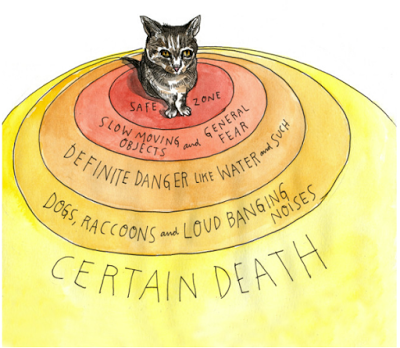I am excited about something that happened last week: I got a really nice email from Stefanie Sanders at Canvas (the one who introduced me to the genius API for global date changes), and she asked me if I would be interested in doing some CanvasLIVE presentations/demos for the kinds of things I have been developing over the past few months like the Twitter4Canvas project, the way I do class announcements with an embedded blog, the countdown widget, etc.
First off, I was just totally flattered that she had been reading about my experiments; I do these things because they are really fun and useful just for me, but when they are useful to others, that is even better.
More importantly, this again shows me how Canvas is willing to reach out and work with faculty, including people like myself who are not big fans of the LMS as a system. So, I wanted to take a few minutes in this post to say something about my history with Instructure, because their proactive outreach has been going on for a long time!
Way back in 2010, Cory Reid got in touch with me when Instructure was getting started and asked me to try their new LMS. I’m a total nobody at my school (just a year-to-year online adjunct), but I’m a noisemaker online, and he had seen me posting in education Nings and other public places online about my dissatisfaction with D2L. I was surprised to get his email, and I wrote back and said I wasn’t interested because I saw no point in another LMS that was closed. He wrote back and assured me that Canvas was different: I would be able to share course pages created at Canvas on the open Internet with a normal URL, no log-in required. That got my attention!
So, a very nice person named Devlin Daley did a demo for me and, much to my own surprise, I was really impressed. Instructure WAS different. The pages WERE open. I mocked up a Latin Composition course (eegad, I just checked: the pages are still up: wow!), hoping that my school would agree to let me teach a Latin Composition course online both as a contribution to the Latin program and as an experiment in using Instructure. That went nowhere (my school has refused to ever let me teach Latin online, alas, even though Latin is my actual academic specialty). As a result of my school declining the course and also being very committed to D2L, nothing came of that experiment, but I followed Instructure’s progress with great interest; the open course content was the key factor that motivated me.
At the same time, as Instructure grew and Canvas gained more and more clients, I was frustrated by the ways it appeared to be falling into some of the same closed, controlling features of the old-school LMSes. Yet even when I was complaining about Canvas (as when I was a student in a Canvas course for HumanMOOC), there was positive engagement from people at Instructure like Brian Whitmer and Jared Stein. That also really impressed me! For any kind of education and development, there must be open and honest feedback. Learners need feedback, and so do teachers, and so do technologists. I would also occasionally get emails from developers at Instructure, asking my opinion about some things they were trying. I thought that was really cool, and I was always glad to write back and share what I had learned from my own experiments in teaching online.
So, based on those positive experiences, I did not hesitate to participate in the Canvas roll-out at my school this year (soft roll-out this year; Canvas for all courses next year). Things went really smoothly, and my students have been pleased with Canvas, both in my classes and in their other classes that are already using Canvas (I wrote about my student Canvas survey here).
In addition, because the openness of Canvas courses allowed me to share my experiments with other faculty at my school, I created some Canvas courses to demonstrate the kinds of things that really interest me: javascript widgets and other dynamic content delivery that can bring the “live” Internet into online spaces, including Canvas course spaces. That has actually turned out to be really fun, and I’ve been learning some things along the way that have been useful for my classes too. I started with a Growth Mindset Playground in the summer of 2016 (that one is a bit of a mess as I was just learning how to use Canvas), and based on what I learned from that I created my Canvas Widget Warehouse over the winter break (that was so much fun), and I just now set up my favorite experiment so far: Twitter4Canvas.
So, here we are now, 7 years after my first contact with the people at Instructure. I’m still a foe of the LMS as a default for online teaching, but at the same time I am really pleased at the way the openness of Canvas courses does let me connect and share with others. You know, like on the real Internet! 🙂
But seriously, as much as I would like to call a moratorium on the LMS for a year (using it only for enrollment and grading), and thus encouraging/forcing faculty to try other online options, I know that is not going to happen. The LMS is here to stay, and if I want to make a positive contribution to the development of online learning in higher ed (and I do), then I need to find a way to contribute to what people are doing with the LMS. And Canvas, with its open courses, makes that a viable proposition.
About CanvasLIVE (i.e. the “live” part): people who know me know that I am not keen on synchronous events; I’m the Queen of Asynchrony. Video hangouts and such are usually not my thing… but I’m going to set a growth mindset challenge to myself to get out of my comfortable asynchronous zone and try something new by working with the Canvas Community on these CanvasLIVE events. I’m excited that I can make my Internet widget magic work inside Canvas, and in my posts here in the coming week I’ll brainstorm some strategies I can use in presenting that to people who are new to the world of javascript magic and widgetry. Then … I will do my best to be synchronous.
And here’s a growth mindset cat to inspire me to take some risks and get synchronous:
That is a meme I made inspired by Tibby the cat who sees circles of fear all around; find out more about Tibby here: The Rumpus Interview with Caroline Paul and Wendy Macnaughton, creators of Lost Cat: A True Story of Love, Desperation, and GPS Technology.
I’m ready to cope with the slow moving object that is synchronous Google Hangouts. I just need to remember to… breathe. 🙂
Crossposted at OU Canvas Community.


I just love every part of this so much I can’t even bring myself to leave specific praise for any one part. Thank you Laura for all you’ve done. The Canvas community will always be here to learn and share with you.
Thank you so much, Adam! I’m going to have fun brainstorming and sharing back to see what will be most useful! 🙂